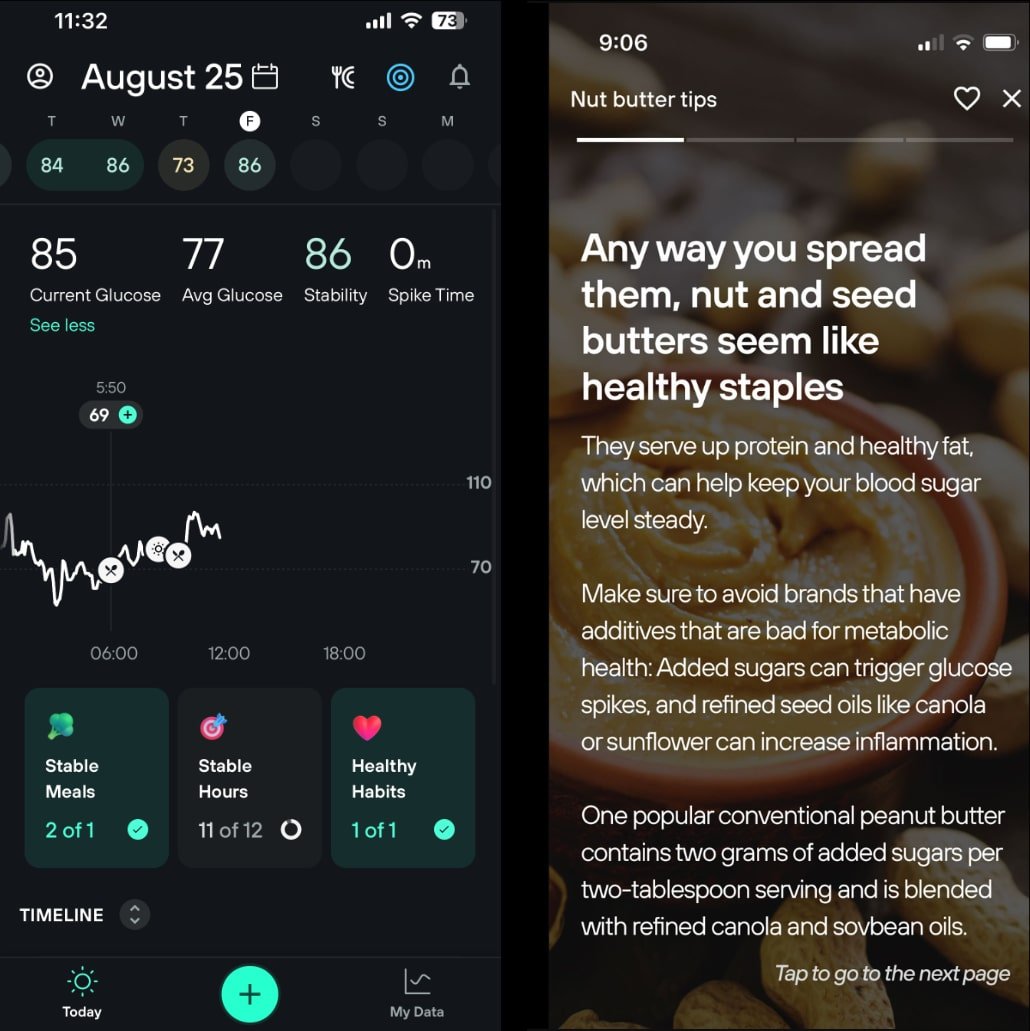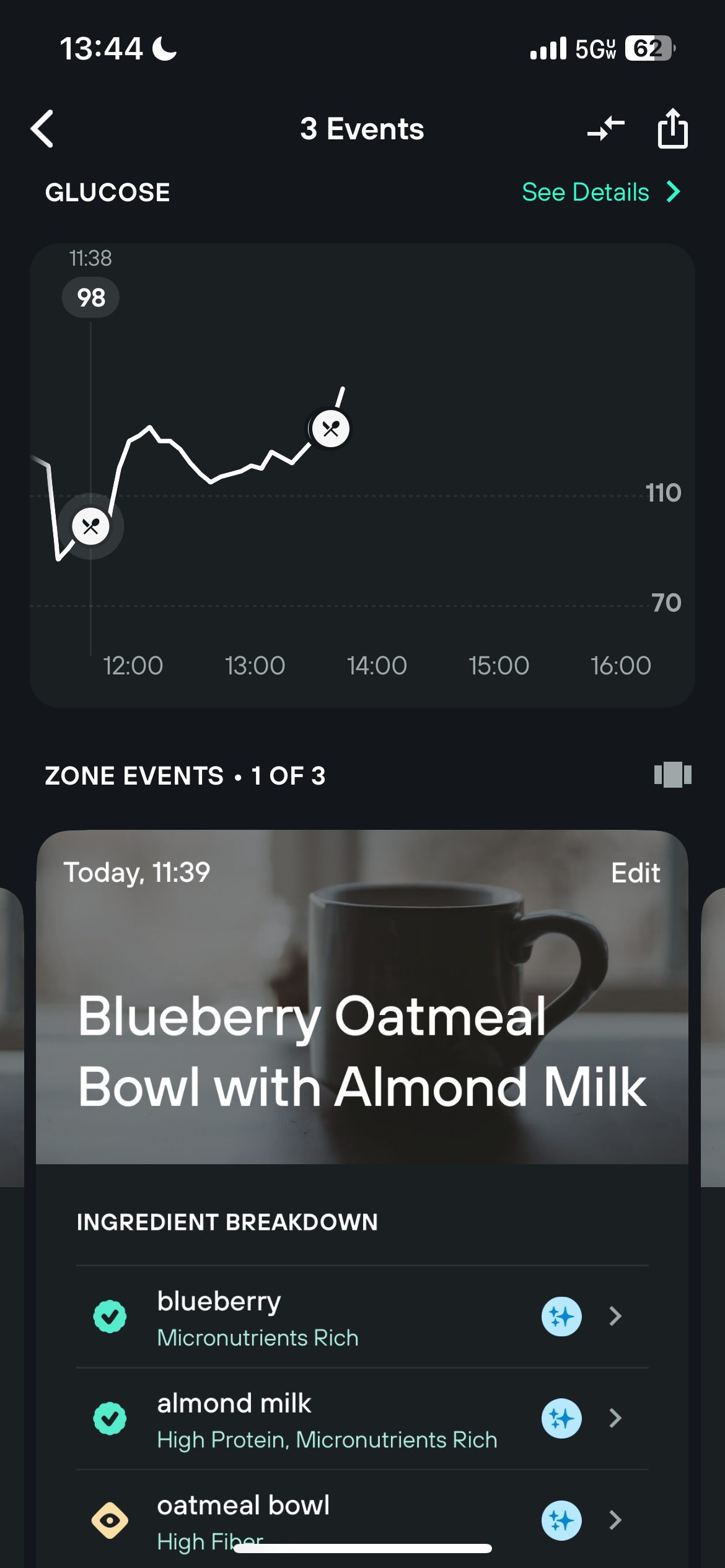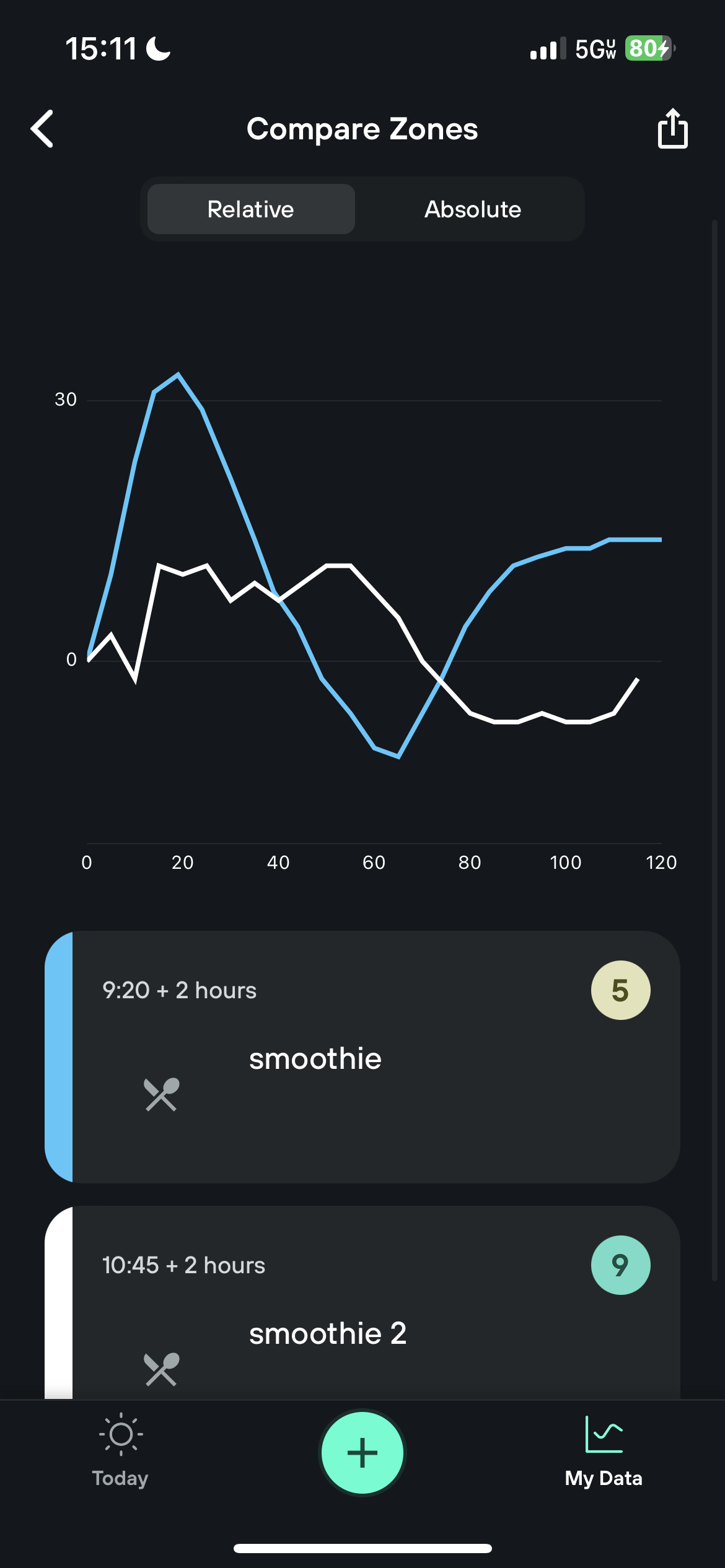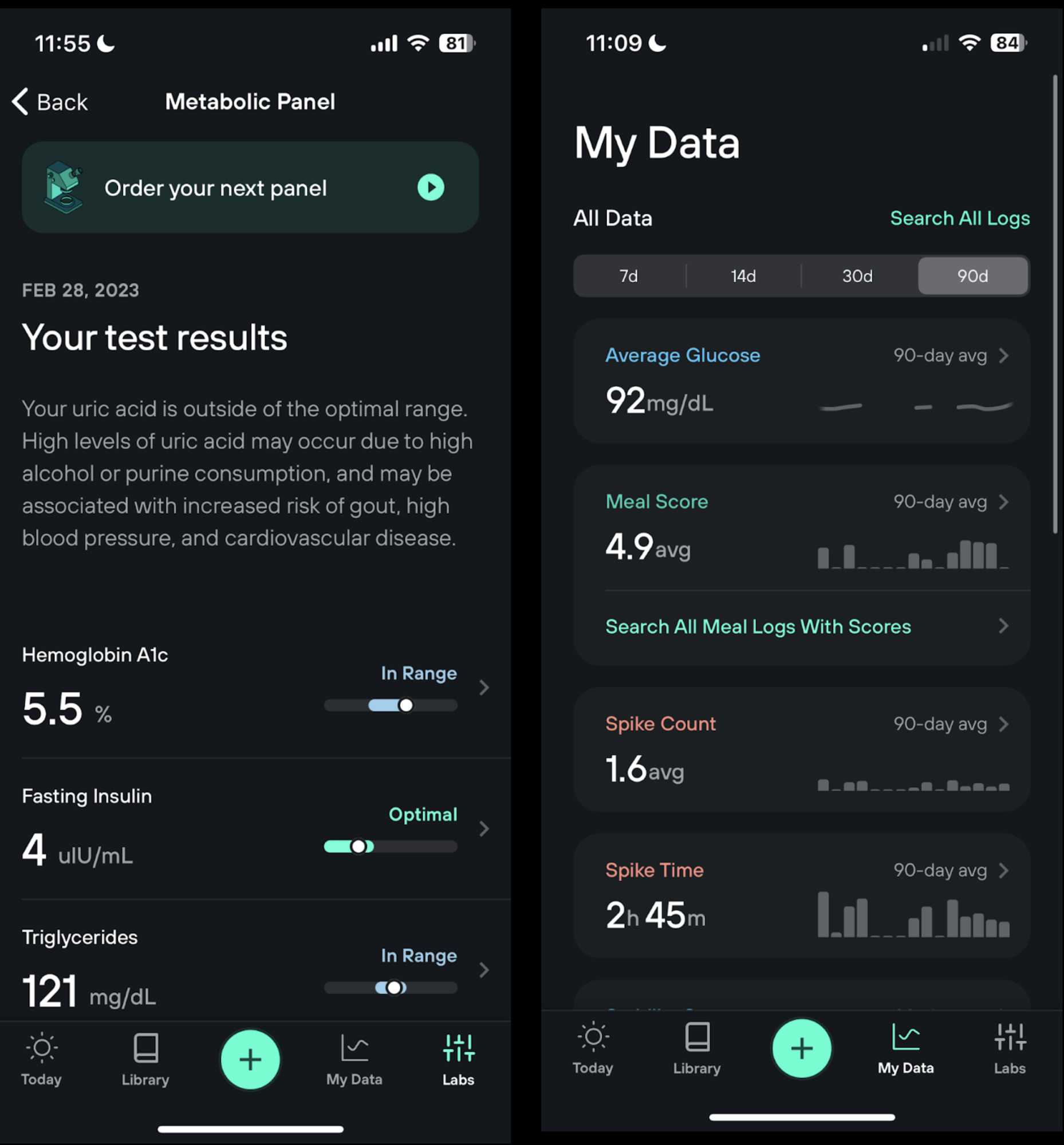If you’re confused about what to eat, you’re not alone. Eight in ten people say they come across conflicting information about nutrition, and 60% say it makes them doubt their food choices.
Part of the challenge is that it’s difficult to do highly reliable nutrition studies, and experts are still arguing about fundamental questions like the root of weight gain or how to think about cholesterol.
The truth is that there is no one perfect diet that works for everyone all the time. Our bodies and circumstances are all different and require different nutrition to function best at any given moment.
But that is actually great news. It means you have more nutritional freedom than you might think: just about any nutritional approach, from keto to vegan to paleo, can be optimized for your individual metabolic health. The key? Getting precise, unambiguous data about how food—and the behavior around it—impacts your body.
Here’s how using Levels with continuous glucose monitoring can cut through the clutter and confusion to unlock your optimal diet.
What do we mean by optimal diet?
Optimal is a key word here as it recognizes that your ideal diet depends not only on your physiology (as we’ll see below) but also on your goals: are you trying to lose weight? To build muscle? To deal with a chronic condition? What works for you will change over time, so we define optimal as a diet that helps you meet your needs while adhering to a few fundamental principles:
1. The ideal diet should support stable glucose.
Glucose is the primary fuel source for every cell in your body (along with fat). Metabolic health is about how your body creates and uses that energy. If your metabolic machinery functions well, you feel and operate at your best. When it doesn’t, systems break down, our cells sustain damage, and the implications can be short-term (fatigue) or long-term (chronic disease).
You can impact your metabolic health by eating to avoid large glucose spikes and crashes. Over time, these large fluctuations can drive harmful processes like insulin resistance, which is when your body can no longer efficiently move circulating glucose into cells. Prediabetes and Type 2 diabetes are just names for advanced insulin resistance that result in chronically high glucose and drive other conditions, from heart disease to Alzheimer’s.
What causes glucose spikes varies [see below], but avoiding added sugars and refined carbohydrates like white flour are generally good strategies.
2. The ideal diet contains enough micronutrients
You could consume vodka and bacon all day and maintain stable glucose, but that wouldn’t be healthy. That’s because your body also needs a wide variety of micronutrients, which include vitamins, minerals, trace metals, and antioxidants. These serve as crucial links in the millions of cellular processes that keep us running, as well as molecular building blocks and activators of chemical reactions. Selenium, zinc, and omega-3 are just a few examples.
Most of our micronutrients come from food, and the best way to ensure you’re getting optimal levels is to consume a wide variety of whole, unprocessed food—think nuts, seeds, beans, vegetables, fruit, and protein.
3. The ideal diet delivers enough protein and fiber.
Most of us don’t consume enough of these two vital macronutrients. Protein is the substrate for not just muscle but just about every tissue in the body. It also helps us feel full, supports hormones and immunity, and helps stabilize our glucose response to meals. While the recommended daily amount is 0.8g/kg of body weight, the optimal may be closer to 1.2-2g/kg.
Fiber also helps slow our body’s glucose absorption, stabilizing blood sugar. In addition, it feeds crucial bacteria in our microbiome, which plays a significant role in our overall health. The USDA recommends 22-34 grams daily, but Levels advisors recommend closer to 50 grams.
How Levels Helps:

- Our Stability Score [left] indicates how well you’re staying in the optimal range of 70–110 mg/dL. This range is narrower than other guidelines but is based on our read of the current research and the input of our expert advisors.
- Our Food Insights [right] and Levels Food Guide point you toward ingredients rich in micronutrients and macronutrients that also help keep blood sugar stable.
Why your diet is unique to you
As discussed above, certain principles apply to nearly everyone trying to be healthy. However, our specific needs vary depending on several factors. For example, how much protein you need is impacted by age, sex, fitness level, other conditions, and genetics.
But of the principles above, glucose stability is perhaps the most individual. That’s because there is solid evidence that foods affect us differently from a glycemic perspective. Nearly everyone will see a glucose spike from a candy bar, but bananas, beans, rice, and tomatoes are all examples of seemingly healthy foods that can cause significant glucose rises in some people but not others.
This individuality was most dramatically shown in an Israeli study from 2015 in which 800 participants wore continuous glucose monitors (CGM) for a week and ate various standardized foods. In one example, two people ate a banana and a cookie, each containing around 20g of carbs. Their responses were the exact opposite of each other. Researchers found similar variation in response to bread, with glucose rises varying from an average of 15 mg/dL to 130 mg/dL.
That’s why a crucial part of using Levels is experimentation. You simply have to try many foods to see how your body responds. Only by tracking data and correlating it to your lived experience can you dial in the nutrition and patterns that work best for you.
How Levels Helps:

Levels built-in Meal Logging allows you to keep track of your meals and individual ingredients and connects them automatically to your blood sugar response, even producing a simple score to help you see which consistently spike you and which you can eat with minimal response, or when paired with fat, protein, and exercise.
How Data Can Inform Your Diet
Finally, it’s not just your physiology that impacts your response to food—context matters too. How you slept last night, when you exercised, the order in which you eat, the quantities you eat—all of these can cause you to have a different glucose response to the same food you ate last week.
For example, one study showed that even one night of four hours of sleep impaired otherwise healthy adults’ ability to process glucose the next day. Another recent study suggested it’s not just hours slept—participants who varied their bedtime suffered metabolically the day after.
How Levels Helps:

- The Meal Compare feature lets you directly contrast glucose curves from two meals to compare ingredients—say, brown rice versus white—and run experiments like eating the same breakfast with or without a workout.
- Levels can import sleep and exercise data directly from Apple Health and Google Fit, including data shared by other sleep trackers such as Whoop. The app then factors this data into meal scores and personal insights.
Why Long-Term Trends Matter
As you can see, eating for metabolic health is not a hack, a single sprint, or even a seasonal project. Instead, it’s about finding habits and foods that work for you, so you can sustain them over time, building long-term health and keeping your body functioning optimally as you age. You don’t need to be perfect to optimal—you need to be moving in the right direction.
How Levels helps:

- Levels Labs [left] is our blood-testing service that lets you look beyond glucose to other vital metabolic markers, including insulin, ApoB (cholesterol), and uric acid. You can order the at-home test as often as you like, and the results show up directly in the app, along with guidance for interpreting them from Levels metabolic experts and personalized advice for improvement.
- Levels shows you up to 90 days of long-term data [right] across several factors, from average glucose to exercise and sleep trends. With this data, you can connect your new, improving habits to tangible outcomes, like lower spike time or waking glucose compared to when you started.
 Ready to learn more about your optimal diet?
Ready to learn more about your optimal diet?
As a Levels member, you get access to the latest continuous glucose monitors, delivered directly to your home on any schedule you like, as well as unlimited access to the Levels app and all the features you see here, plus many more. Click here to become a Levels member.


 Ready to learn more about your optimal diet?
Ready to learn more about your optimal diet?






